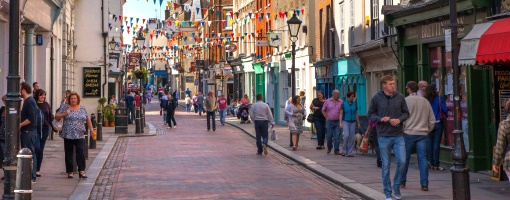Despite a spate of High Street closures this year increasing talk of the death of physical retail, several industry stakeholders have argued that re-designed brand outposts are still a crucial part of any retailer’s omnichannel strategy.
Nearly 650 shops and restaurants have shut since the start of 2018, or are at risk of closure, according to analysis by BBC 5 Live's Wake Up to Money programme. Maplin and Toys R Us, which filed for administration on the same day in February, account for half that total and are arguably emblematic of how not to run a retailer in the digital age.
The latest figures from the British Retail Consortium and KPMG showed the sharpest UK retail sales decline since they started recording in January 1995, with a drop of by 4.2 per cent compared with April 2017.
Emily Buckman, global strategic consultant at mobile engagement platform Urban Airship, accepted that there is growing concern among companies with large bricks and mortar footprints, but argued that there are many examples of traditional businesses updating their in-store strategy and making gains.
“It’s all about creating strong experiences to drive brand loyalty – take Sephora for example, they’ve reduced the amount of stores and focused on a ‘Studio’ concept that has a layout optimised for interactions rather than selling,” she explained. “Staff are equipped with tablets, so they can facilitate online orders and see if things are in stock – it’s digital, but with the human touch.”
A new whitepaper from customer experience agency SET also stressed that physical and online retail need not be a zero-sum game, pointing out that 80 per cent of everything purchased today is still done in person. “Technology alone cannot consistently provide good customer service, but technology designed to enhance human experiences can exceed expectations every time,” read the document. “Man and machine working together is the single most powerful and effective method to grow retail.”
Another recent report from Accenture noted that despite continued growth in digital commerce, the physical store will continue to be the largest revenue producing channel until at least 2026. “Technology is enabling frontline engagement with customers in store… we see more high engagement social interaction in brick and mortar,” stated the strategy consultant.
SET also cited the trend for e-commerce giants like Amazon, Google and Alibaba investing in physical stores for their own branded service model, while also buying retail brands and spaces wholesale.
Even a hedge fund manager betting on the death of the High Street suggested that there was still a place for brands to interact with customers. Eurof Uppington, portfolio manager of disruptive innovation strategy at Quaero Capital, said stores should be complementary to a brand’s website, rather than the other way round. “If you’re truly omnichannel, then all you need are a few ‘brand temple’ outposts where people can get inspired and fitted, while continuing to order online.”
Some retailers are taking note of this behaviour and are integrating new technologies such as beacons, mobile wallet passes, mobile apps and notifications in order to provide an improved shopping experience.
John Lewis, for example, has recognised the power of beacons - a geolocation technology that offers proximity data within a store or structure and can be used with mobile apps and notifications to leverage a customer’s location. The department store chain uses them to detect when a customer, who has ordered something and has the company’s app, is within 70 metres of a shop. Once in the vicinity, it automatically sends a push notification asking the shopper if they plan to pick up the purchase they ordered, in-store. If the customer clicks ‘yes’, a sales assistant will prepare the product before the customer reaches the counter.
Buckman from Urban Airship said the data collected from app engagement is a treasure trove for retailers – if analysed correctly, they can create more targeted in-store strategies to encourage customers into the shop.
At this year’s Retail Business Technology Expo, several industry experts talked through different strategies for using technology in-store. For instance, retail property firm Hammerson is developing a visual search app called Style Seeker, which lets shoppers to take a picture of a piece of clothing and discover similar alternatives at physical outlets within its malls.
Meanwhile, Insider Trends’ head of trends Cate Trotter said that technology can be the “magical connector” between brand and customer, but it should be in the background, citing very popular but decidedly low-tech stores she witnessed on a recent trip to New York – Glossier and Outdoor Voices.
“Don’t worry about spending money on things like large, expensive touch screens on the shop floor – they’re a novelty that will be used for about 15 seconds,” she commented. “Shoppers are there to pick up product and talk to staff – it’s all about making a connection.”
Beyond Channels: Redefining retail with Unified Commerce
This Retail Systems fireside chat with Nikki Baird, Vice President, Strategy & Product at Aptos will explore how unified commerce strategies enable retailers to tear down these barriers and unlock new levels of operational agility and customer satisfaction.
The future of self-checkout: Building a system that works for consumers and retailers
In this webinar, industry leaders discussed what the future of self-checkout looks like and how retailers can make the technology work for everyone.
© 2024 Perspective Publishing Privacy & Cookies










Recent Stories